From hard-drinking former super-people to “consulting wizard” detectives, the best supernatural gumshoes—investigators of the private but also the occult—are the ones who should really know better. They’ve stumbled onto apocalyptic conspiracies, gone toe-to-toe with demons and supervillains, and have the curses and scars to prove it. And yet, they just keep getting dragged into the kinds of cases that regular private investigators don’t even know exist.
What can we say? It’s an occupational hazard. Our favorite supernatural detectives are the ones who take their bizarre cases begrudgingly. Like the changeling who gets cursed into investigating a murder; the private eye who must defend a toon accused of offing other toons; and the FBI trainee who becomes an unwitting “Witness” to all manner of magical ridiculousness.
Harry Dresden (The Dresden Files)
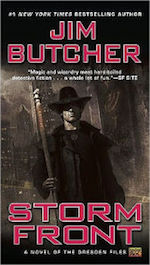 Harry Blackstone Copperfield Dresden may have been named after three stage magicians, but his real sleight of hand is in navigating real-world Chicago and the magical spheres that exist just beyond humans’ reach… to his eternal chagrin, as he gets yanked into every supernatural drama, from werewolves let loose to the vampiric Red Court (who kidnap his girlfriend)—and we haven’t even gotten to the clashing courts of the Summer and Winter Fae, who love using Harry as their reluctant pawn. A wizard PI who wields a revolver and rune-carved staff in each hand, Harry takes on any job, no matter how apocalyptic. —Natalie Zutter
Harry Blackstone Copperfield Dresden may have been named after three stage magicians, but his real sleight of hand is in navigating real-world Chicago and the magical spheres that exist just beyond humans’ reach… to his eternal chagrin, as he gets yanked into every supernatural drama, from werewolves let loose to the vampiric Red Court (who kidnap his girlfriend)—and we haven’t even gotten to the clashing courts of the Summer and Winter Fae, who love using Harry as their reluctant pawn. A wizard PI who wields a revolver and rune-carved staff in each hand, Harry takes on any job, no matter how apocalyptic. —Natalie Zutter
John Persons (Hammers on Bone)
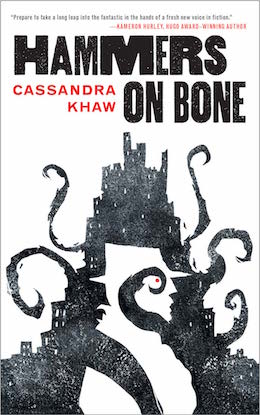 John Persons, the private eye at the dark heart of Cassandra Khaw’s fantasy noir, is the perennial gumshoe: He’s got the wardrobe, the slang, the fast-talking way of getting to the heart of a case. But the creature inhabiting Persons’ human form is thousands of years old, and knows better than to get wrapped up in the kinds of cases that aren’t worth the price. That is, until an eleven-year-old drops a piggy bank on his desk and asks him to kill his stepfather—”because he’s a monster.” And “because you’re a monster too.” Just like that, Persons is dragged into trouble. —Natalie Zutter
John Persons, the private eye at the dark heart of Cassandra Khaw’s fantasy noir, is the perennial gumshoe: He’s got the wardrobe, the slang, the fast-talking way of getting to the heart of a case. But the creature inhabiting Persons’ human form is thousands of years old, and knows better than to get wrapped up in the kinds of cases that aren’t worth the price. That is, until an eleven-year-old drops a piggy bank on his desk and asks him to kill his stepfather—”because he’s a monster.” And “because you’re a monster too.” Just like that, Persons is dragged into trouble. —Natalie Zutter
Jessica Jones (Alias, Jessica Jones)
 Okay, Jessica only works with the supernatural insofar as superhero universes often have elements of magic and the supernatural bound up in them. And she’s only a detective for a little while in the comics (though her current TV show is focusing on that aspect thus far). But Jessica as a character has all the hallmarks of a grumbling private eye; she’s no-nonsense, she’s blunt, she’s sardonic. She’s a romantic deep down under that scruffy exterior. Her television incarnation’s love of Wild Turkey cannot be understated. Whether she’s working as a detective, a reporter, or as a super-person, Jessica may not always be the hero she wants to be, but she’s definitely the hero we need. —Emmet Asher-Perrin
Okay, Jessica only works with the supernatural insofar as superhero universes often have elements of magic and the supernatural bound up in them. And she’s only a detective for a little while in the comics (though her current TV show is focusing on that aspect thus far). But Jessica as a character has all the hallmarks of a grumbling private eye; she’s no-nonsense, she’s blunt, she’s sardonic. She’s a romantic deep down under that scruffy exterior. Her television incarnation’s love of Wild Turkey cannot be understated. Whether she’s working as a detective, a reporter, or as a super-person, Jessica may not always be the hero she wants to be, but she’s definitely the hero we need. —Emmet Asher-Perrin
Raymond Electromatic (L.A. Trilogy)
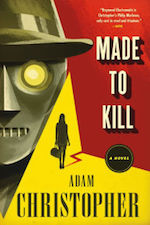 Here’s the thing: Ray—the last remaining robot from a government experiment—only pretends to be a PI, down to the wardrobe and hat. While he and Ada, his girl Friday in computer form, were designed to be an eclectic private detective agency, Ada’s prime directive to turn a profit prompted her to reform both of them into a much more lucrative business: killers for hire. However, their latest gig combines Ray’s unique talents, as silver-screen ingenue Eva McLuckie contracts him to find her missing costar, and then dispose of him. Not to mention that what should be a straightforward kill instead uncovers a massive, continent-spanning conspiracy including mind transplantation and movie screens. And while Ray lacks the human empathy that would stop him from murdering people in cold blood (er, oil?), he makes for a sympathetic detective when he must solve the mystery of what happens after his memory tapes get wiped every 24 hours. —Natalie Zutter
Here’s the thing: Ray—the last remaining robot from a government experiment—only pretends to be a PI, down to the wardrobe and hat. While he and Ada, his girl Friday in computer form, were designed to be an eclectic private detective agency, Ada’s prime directive to turn a profit prompted her to reform both of them into a much more lucrative business: killers for hire. However, their latest gig combines Ray’s unique talents, as silver-screen ingenue Eva McLuckie contracts him to find her missing costar, and then dispose of him. Not to mention that what should be a straightforward kill instead uncovers a massive, continent-spanning conspiracy including mind transplantation and movie screens. And while Ray lacks the human empathy that would stop him from murdering people in cold blood (er, oil?), he makes for a sympathetic detective when he must solve the mystery of what happens after his memory tapes get wiped every 24 hours. —Natalie Zutter
Eddie Valiant (Who Censored Roger Rabbit?)
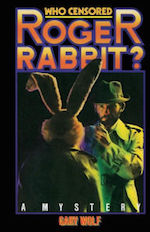
Eddie Valiant has to deal with living cartoon characters, and even if that’s relatively normal in his world, it fits pretty snuggly in the realms of supernatural from our world perspective. Based on classic noir tropes, Valiant is a chimney-smoking P.I. who ends up having to figure out who “censored”—or killed—cartoon mid-lister Roger Rabbit. (Or in the case of the film based off the novel, who framed the poor sop for more than one murder.) His investigations lead him toward the 36-year-old infant Baby Herman, and Roger’s femme fatale wife, Jessica, and it only gets more interesting from there. Valiant keeps swearing off toon cases, only to get pulled back into their orbit no matter his protestations. You’d think the guy could take the hint after a while—he’s clearly the only one for the job. —Emmet Asher-Perrin
October Daye (October Daye series)
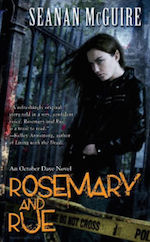 You can’t blame changeling Toby Daye for wanting absolutely nothing to do with the faerie side of her heritage: After embracing her supernatural roots, becoming a loyal knight to the duke and the go-to PI for magical matters, Toby gets transformed into a koi fish, cursed to live 14 years in a pond while the rest of the world keeps turning. Upon returning to her human form—having lost her husband and daughter—Toby would rather bag groceries than track down dangerous fae. But she didn’t count on Countess Evening Winterrose—a mentor of sorts, if not the warmest person—being brutally murdered and leaving a geas on Toby’s answering machine. While other PIs are motivated by briefcases full of money or sad-eyed dames, Toby’s reason for returning to her roots is much more straightforward but no less sinister: The geas binds her to find Evening’s killer, or die herself. —Natalie Zutter
You can’t blame changeling Toby Daye for wanting absolutely nothing to do with the faerie side of her heritage: After embracing her supernatural roots, becoming a loyal knight to the duke and the go-to PI for magical matters, Toby gets transformed into a koi fish, cursed to live 14 years in a pond while the rest of the world keeps turning. Upon returning to her human form—having lost her husband and daughter—Toby would rather bag groceries than track down dangerous fae. But she didn’t count on Countess Evening Winterrose—a mentor of sorts, if not the warmest person—being brutally murdered and leaving a geas on Toby’s answering machine. While other PIs are motivated by briefcases full of money or sad-eyed dames, Toby’s reason for returning to her roots is much more straightforward but no less sinister: The geas binds her to find Evening’s killer, or die herself. —Natalie Zutter
Lieutenant Abbie Mills + Ichabod Crane (Sleepy Hollow)
 For the first two seasons of Fox’s Sleepy Hollow, we were given a great supernatural detective in the form of Abbie Mills, played by Nicole Beharie. She’s initially set up as the show’s Scully, the skeptical, by-the-books police officer who is dismissive of the supernatural nonsense around her, and just wants to split Sleepy Hollow to go off for FBI training at Quantico. Instead she finds herself tied to time-traveling Revolutionary War soldier Ichabod Crane, forced to be a “Witness”, and locked in a battle to stop the Apocalypse. She’s begrudging about the supernatural aspect of her role as a detective, but only because, as viewers gradually learn, her family has been cursed to deal with apocalyptic doom for hundreds of years, and it’s left all of them broken. Abbie’s greatness lay in her willingness to confront this past, and tackle supernatural mysteries despite the risk. If you’d like to follow Abbie on a literary adventure, we recommend Keith R.A. DeCandido’s Sleepy Hollow: Children of the Revolution, which takes Abbie and Ichabod on a hunt for a Revolutionary War-era artifact! —Leah Schnelbach
For the first two seasons of Fox’s Sleepy Hollow, we were given a great supernatural detective in the form of Abbie Mills, played by Nicole Beharie. She’s initially set up as the show’s Scully, the skeptical, by-the-books police officer who is dismissive of the supernatural nonsense around her, and just wants to split Sleepy Hollow to go off for FBI training at Quantico. Instead she finds herself tied to time-traveling Revolutionary War soldier Ichabod Crane, forced to be a “Witness”, and locked in a battle to stop the Apocalypse. She’s begrudging about the supernatural aspect of her role as a detective, but only because, as viewers gradually learn, her family has been cursed to deal with apocalyptic doom for hundreds of years, and it’s left all of them broken. Abbie’s greatness lay in her willingness to confront this past, and tackle supernatural mysteries despite the risk. If you’d like to follow Abbie on a literary adventure, we recommend Keith R.A. DeCandido’s Sleepy Hollow: Children of the Revolution, which takes Abbie and Ichabod on a hunt for a Revolutionary War-era artifact! —Leah Schnelbach
Constantine (Hellblazer)
 John Constantine really doesn’t want to help you with your mysterious problem, because if he does… you’ll probably die. Then again, if he doesn’t, you’ll also probably die. So he has to try? But he’d rather not. It’s a vicious cycle for the occult detective, and his less-than-savory means are balanced out with his roughly humanistic point of view. Constantine isn’t a cuddly guy, but he does believe that humanity deserves to be what it will, and that people are pretty okay overall. He just has the most rotten luck, coupled with a tendency to meddle when he shouldn’t. We see this over and over, as Constantine loses people who are close to him, and still gets back out there every time he smells a little brimstone. It’s a bad habit that he can’t seem to rid himself of. —Emmet Asher-Perrin
John Constantine really doesn’t want to help you with your mysterious problem, because if he does… you’ll probably die. Then again, if he doesn’t, you’ll also probably die. So he has to try? But he’d rather not. It’s a vicious cycle for the occult detective, and his less-than-savory means are balanced out with his roughly humanistic point of view. Constantine isn’t a cuddly guy, but he does believe that humanity deserves to be what it will, and that people are pretty okay overall. He just has the most rotten luck, coupled with a tendency to meddle when he shouldn’t. We see this over and over, as Constantine loses people who are close to him, and still gets back out there every time he smells a little brimstone. It’s a bad habit that he can’t seem to rid himself of. —Emmet Asher-Perrin
Narrator + Friend (“A Study in Emerald,” from Shadows Over Baker Street)
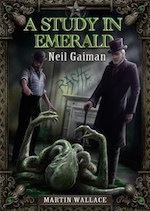
“A Study in Emerald” features one of the most famous detectives of all time going toe-to-tentacle with the eldritch gods of H.P. Lovecraft. For the first few paragraphs of the story, you’d be forgiven for thinking this was just a straight-ahead retelling of a Sherlock Holmes story, but then, when the Great Detective is summoned to a crime scene in Whitechapel, you learn that the victim has entirely too many limbs to be a human. Plus there’s all the green blood… and then you meet Queen Victoria:
She was called Victoria, because she had beaten us in battle, seven hundred years before, and she was called Gloriana, because she was glorious, and she was called the Queen, because the human mouth was not shaped to say her true name. She was huge, huger than I had imagined possible, and she squatted in the shadows staring down at us, without moving.
The Narrator and his Friend aren’t so much begrudging gumshoes so much as classic Doyle detectives. They use deduction to track a murderer, and trust in their reason ad attention to detail to guide them to the correct answers. To say much more would spoil the story, so I’ll simply urge you to go read it. “A Study in Emerald” was originally written for a collection called Shadows Over Baker Street, a collection of stories combining the worlds of Arthur Conan Doyle and H. P. Lovecraft, has since appeared in Gaiman’s collection Fragile Things, but you can read it online as a Victorian-themed broadsheet here. And once you’ve finished it, you can check out the Lovecraft Reread’s take on the story here! —Leah Schnelbach
Honorable Mention: Dirk Gently (Dirk Gently’s Holistic Detective Agency)
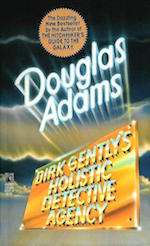 Honorable mention to Dirk Gently, who emphatically does not believe in the supernatural. He thinks the whole thing an elaborate con, but that doesn’t seem to change the fact that remarkable things keep happening around him… so that makes him begrudging, in his own naysay-ish way. Besides, if “holistic” detecting isn’t its own brand of paranormal investigation, then I don’t know what is. —Emmet Asher-Perrin
Honorable mention to Dirk Gently, who emphatically does not believe in the supernatural. He thinks the whole thing an elaborate con, but that doesn’t seem to change the fact that remarkable things keep happening around him… so that makes him begrudging, in his own naysay-ish way. Besides, if “holistic” detecting isn’t its own brand of paranormal investigation, then I don’t know what is. —Emmet Asher-Perrin
Who are your favorite begrudging supernatural gumshoes? Let us know in the comments!










